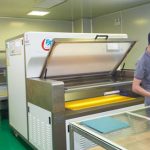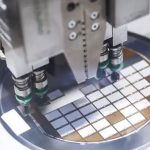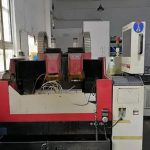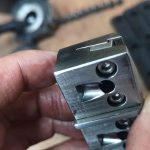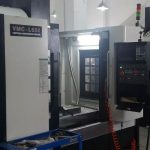
Current Development Status of U.S. Manufacturing Industry
1. The U.S. manufacturing industry makes a significant contribution to economic growth and employment.
Since the financial crisis, the United States has increased investment in basic elements of innovation, vigorously revitalized the U.S. manufacturing industry, saved the endangered automobile industry, and led the U.S. economy on the track of recovery. The U.S. manufacturing industry shows obvious signs of growth, and the manufacturing industry has made an important contribution to GDP growth and employment growth. According to the latest data from the U.S. Department of Commerce, the growth rate of U.S. manufacturing has exceeded U.S. GDP growth.
Since the second quarter of 2009, U.S. manufacturing real value added has increased by 18%, while U.S. GDP has increased by 11% during the same period. At the end of 2013, the share of U.S. manufacturing in GDP increased to 12.5%. Between February 2010 and May 2014, U.S. manufacturing employment increased by 646,000. U.S. manufacturing also supports millions of jobs elsewhere in the supply chain and in the communities in which it operates. Manufacturing employment has generally increased in states across the United States. The growth in employment in only five states, Michigan, Texas, Indiana, Ohio and Wisconsin, accounted for more than half of the increase in manufacturing employment in the United States. In 2013, U.S. manufacturing exports totaled $1.2 trillion.
2. The manufacturing industry plays a significant role in supporting and promoting innovation.
The U.S. manufacturing industry accounts for 12.5% of GDP, but the manufacturing industry plays an extraordinary role in supporting and promoting R&D and innovation. Manufacturing R&D personnel account for 60% of the total R&D personnel in the United States; 75% of the total R&D investment in the private sector is used in manufacturing; and most patents in the United States are owned by manufacturing companies. On average, U.S. manufacturing companies are more innovative than companies in other industries, and their innovation capabilities are more than twice that of companies in other industries. Taking the period from 2008 to 2010 as an example, more than 30% of manufacturing companies had innovative results during this period, while only 13% of companies in other industries.
3. The United States shows new attraction to manufacturing companies
Due to the high quality of the U.S. labor force, the large market size, the decline in energy costs in recent years, and its traditional advantages in technological innovation, the United States has once again become a hot spot for business investment. The United States ranks as the top location for business investment, according to a survey of global business executives by international management consulting firm Kearney. This is the first time since 2001 that the United States has surpassed China, Brazil, India and other countries to become the world’s number one business investment hotspot. The improvement in the competitiveness of the U.S. manufacturing industry has attracted its multinational companies to return to the United States. According to a survey by the Boston Consulting Group, the number of U.S.-based manufacturing companies planning to move their production back to the United States from China tends to increase. In 2012, 37% of U.S. multinational companies planned to transfer foreign operations back to the United States. In 2013, the proportion of companies with such plans rose to 54%.
4. Emerging technologies are gaining new advantages for U.S. manufacturing
The severe decline in manufacturing during the financial crisis has been significantly reversed today. As a large number of new technologies continue to emerge, new product development time is shortened, and production costs are reduced, the U.S. manufacturing industry has shown new competitive advantages. From laser cutting machines to computer-controlled cutting machines (CNC Routers) to 3D printing, a series of new rapid prototyping and parts making technologies have greatly reduced the cost of prototype development. On the other hand, the United States already has significant advantages in software and digital design. 80% of the world’s software is developed in the United States. The United States leads the world in big data analysis and sensors, and has most of the world’s supercomputers. . Emerging technologies coupled with existing advantages have made innovation and entrepreneurial activities in the U.S. manufacturing industry quite active, showing a new trend of vigorous development. Currently, the creation rate of new manufacturing companies in the United States has reached its highest level since 1993. As new companies are created and existing companies continue to set up branches, the number of manufacturing companies in the United States is increasing rapidly. In 2013 alone, more than 1,400 new companies were created. This trend is widely distributed in various manufacturing industries, such as chemicals, electronics, machinery, etc., to name a few.
The U.S. government’s support policies for manufacturing
1. Strengthen manufacturing policies and strategic deployment
The important contribution of manufacturing to the U.S. economy has always been recognized and emphasized by the government. After the financial crisis, the U.S. government became more aware of the importance of manufacturing to economic growth and employment, and issued a series of policy documents and reports to revitalize the U.S. manufacturing industry and strengthen the research and development of advanced manufacturing technologies as a way to achieve economic recovery and promote the long-term economy. an important means of growth and prosperity. In 2009, the United States introduced the “Framework for Revitalizing U.S. Manufacturing,” which emphasized the need to effectively target every cost factor, starting from improving worker skills, funding new technologies and business practices, developing stable and efficient capital markets, and investing in transportation infrastructure. Vigorously support the manufacturing industry. In 2011, the U.S. President’s Council of Advisors on Science and Technology submitted a report and recommendations to the President on ensuring the U.S.’s leading position in advanced manufacturing. On this basis, in 2012, the National Science and Technology Council of the United States released the National Advanced Manufacturing Strategic Plan, proposing to optimize government investment, improve advanced manufacturing innovation policies, accelerate advanced manufacturing technology innovation, and accelerate the market application of new technologies. A series of strategic deployments have created a more favorable policy environment for the development of U.S. manufacturing and injected new impetus into the development of advanced manufacturing technology and manufacturing.
2. Strive to build the world’s leading advanced manufacturing R&D center
In order to promote economic recovery and rapid growth, the U.S. government has accelerated the deployment of cutting-edge manufacturing technologies in recent years. In addition to continuing to support the national nanotechnology plan, network and information technology research and development plans, etc., it has also launched a number of major cross-departmental plans such as the Materials Genome Project and the National Robotics Technology Plan. The U.S. federal government’s investment in manufacturing R&D increased by 35% in three years, from US$1.4 billion in 2011 to US$1.9 billion in 2014. The Obama administration began building a manufacturing innovation network across the United States in 2012. The initial idea was to build a network of 15 manufacturing innovation institutes, and later proposed expanding the target to 45. The network emphasizes cooperation between government, industry, academia and research, and the sharing of resources and facilities, with financial support jointly provided by the U.S. federal government and the private sector. Each Manufacturing Innovation Institute is expected to receive a total of $70 million to $120 million in federal funding, with funding periods ranging from five to seven years depending on its technology capital intensity and scope of focus areas. If combined with expected matching non-federal funding (e.g., at a 1:1 ratio), the total funding for a manufacturing innovation institute would reach $140 million to $240 million.
As of the end of December 2015, nine manufacturing innovation research institutes had been announced, five of which were located in Ohio, North Carolina, Michigan, Illinois and Tennessee. Five of the above institutes are funded by the U.S. Department of Defense, three are funded by the U.S. Department of Energy, and one is funded by multiple U.S. departments. Their key areas of focus include: additive manufacturing (3D printing), new generation power electronics, and digital manufacturing. , intelligent manufacturing, flexible hybrid electronics, advanced synthetic materials, lightweight and modern metal manufacturing, etc. In the new fiscal year 2016 budget proposal, the U.S. government proposed a special appropriation of $350 million to fund existing manufacturing innovation institutes and support the U.S. Department of Commerce, U.S. Department of Agriculture, U.S. Department of Defense, and U.S. Energy The Ministry has built seven new manufacturing innovation research institutes. In this way, Obama is expected to complete the construction of 15 manufacturing innovation institutes by the end of his presidential term. The new budget also includes a $1.9 billion directive appropriation proposal, hoping to use this funding to support 29 more research institutes to help achieve the long-term goal of building 45 manufacturing innovation research institutes in 10 years.
3. Pay attention to the advanced manufacturing partnership program
The Advanced Manufacturing Partnership Program was launched by US President Obama and cnc machining usa company in 2011 to maintain and enhance the United States’ leading position in advanced manufacturing. The mission of the Advanced Manufacturing Partnership Program includes promoting the development of advanced manufacturing technologies, increasing employment and attracting investment, and promoting cooperation between government, industry, academia, and research. The U.S. government established the Office of Advanced Manufacturing National Programs in the Department of Commerce to be responsible for the interagency coordination of the Advanced Manufacturing Partnership Program.
Based on the recommendations of the President’s Council of Advisors on Science and Technology, Obama launched new measures in October 2014 to strengthen the Advanced Manufacturing Partnership Program and promote the development of advanced manufacturing. The new measures focus on three aspects:
(1) Promote innovation
The government has increased investment by more than $300 million to support emerging manufacturing technologies that are critical to U.S. competitiveness. This funding is jointly invested by the U.S. Department of Defense, the U.S. Department of Energy, the U.S. Department of Agriculture, and the National Aeronautics and Space Administration (NASA) to support three key technologies established by the Advanced Manufacturing Partnership Program – advanced materials (including synthetic materials and bio-based materials), advanced sensors and digital manufacturing. The U.S. government has proposed that the advanced experimental facilities of national laboratories should be opened to manufacturing companies. The U.S. National Science Foundation, the U.S. Department of Energy, and NASA are taking steps to strengthen R&D cooperation between industry and universities and provide “technology testbeds” at U.S. federal research facilities to facilitate the design, prototyping, and manufacturing of new products and processes. test.
(2) Expand workforce development strategy
The U.S. Department of Labor has proposed investing $100 million to develop the American Apprenticeship Funding Program to incentivize new apprenticeship models and expand effective apprenticeship models in high-growth fields such as advanced manufacturing. Members of the Advanced Manufacturing Partnership – Dow Chemical Company, Alcoa and Siemens – have pioneered apprenticeships and can provide lessons for other companies looking to adopt apprenticeships as an effective training method.
(3) Improve the environment and support corporate financing
Emphasis is placed on further improving the business environment and supporting corporate financing.
4. Provide funds and convenience for commercialization of manufacturing technology
Manufacturing promotion centers supported by the U.S. Department of Commerce are located across the United States and can provide various services to more than 30,000 small and medium-sized manufacturing companies every year. In view of the innovation gap faced by small manufacturing companies, the U.S. government has used new means to launch an initial five-year investment to support innovative small businesses in the supply chain. The U.S. Department of Commerce’s Manufacturing Promotion Partnership Program focuses on strengthening the capabilities of its manufacturing promotion centers in various states. It plans to invest US$130 million over the next five years to support small manufacturers in 10 states to absorb and utilize new technologies and Bring new products to market.
The U.S. government’s fiscal year 2016 budget proposal once again emphasized the need to help new innovative manufacturing technologies achieve commercial application. In this budget proposal, the U.S. government calls on Congress and the President to jointly launch a public-private partnership of US$10 billion to expand the manufacturing investment fund (Scale-Up Manufacturing Investment Fund) to support emerging advanced manufacturing technologies into commercial production. The goal of this fund is to enable technology invented in the United States to be produced in the United States. This fund is invested by the U.S. government with US$5 billion, matched by private funds of US$5 billion, and is mainly used to bridge the financing gap for new manufacturing companies. This fund program, administered by the U.S. Small Business Administration, encourages private sector investment to support technology-intensive new ventures. If this fund is implemented, it will facilitate entrepreneurial companies to obtain funds and help them transform from ideas to prototype design and then to full-scale commercial production.
5. Optimize the investment environment to attract and retain manufacturing companies
Since 2011, U.S. President Obama has launched the “Choose America” initiative at the Department of Commerce, aiming to attract and retain business investment. The 2015 Appropriations Act provides $10 million in funding for Choose America. In the new budget for fiscal year 2016, Obama proposed to mobilize the entire government to continue to expand and strengthen the “Choose America” operation. At the same time, the U.S. government uses R&D tax breaks to attract companies to return home, and provides tax incentives to companies that move production, investment and jobs back to the United States. In order to attract manufacturing companies to locate in the United States, the U.S. Department of Commerce established a new set of tools in 2014 to help manufacturers evaluate and avoid the hidden costs of offshoring. This new inventory costing tool is provided to businesses by the Manufacturing Extension Center.
According to statistics, foreign direct investment in the United States has increased from US$160 billion in 2012 to US$187.5 billion in 2013. Considering the costs of transportation and other aspects, more and more American companies plan to transfer production back to the United States from developing countries such as China.
6. Actively support manufacturing communities
In order to stimulate investment and create jobs in the manufacturing sector, the Obama administration established 12 “manufacturing communities” in 2014. This is the first manufacturing community established in the United States after the launch of the “Manufacturing Community Investment Partnership” program in September 2013, including the Southwest Alabama Community led by the University of South Alabama and the Economic Development Research Center of the University of Southern California. Communities of Southern California, led by the University of Tennessee, and the Tennessee River Valley, led by the University of Tennessee. The selected communities will receive selective support from economic development funds totaling US$1.3 billion from 11 federal government departments, and can also use the brand effect of “manufacturing communities” to attract more external investment. The common feature of these communities is the establishment of partnerships linking industry, academia, and research to promote innovation. In order to share relevant experiences, the U.S. federal government will also set up a platform for all applicant communities to carry out exchange activities.
Link to this article:U.S. Manufacturing Innovation Policy And Development Trends
Reprint Statement: If there are no special instructions, all articles on this site are original. Please indicate the source for reprinting:Alloy Wiki,thanks!^^



